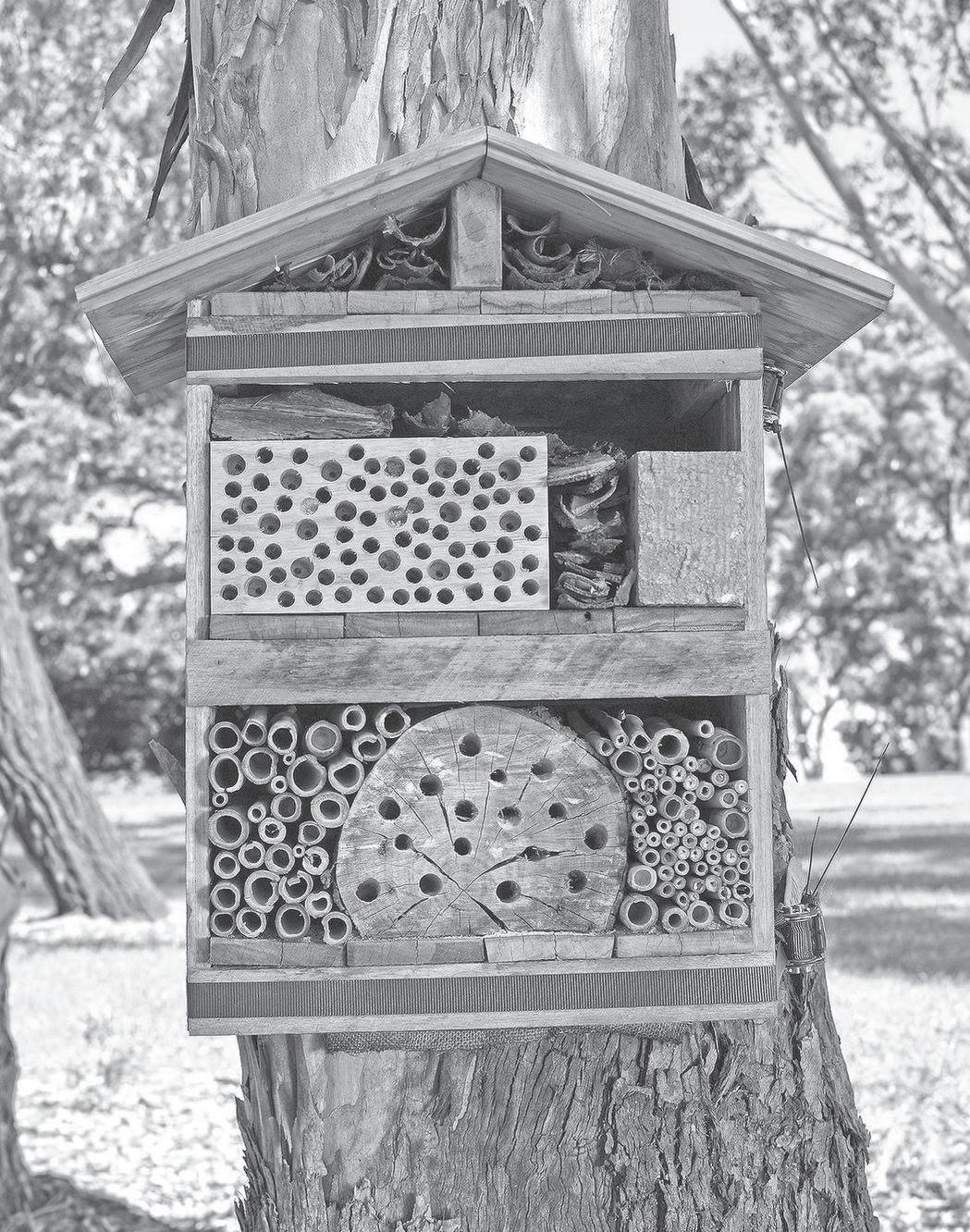
4 minute read
Don’t throw away dried plants build a pollinator nest
By Maddie Ellis
TRIBUNE NEWS SERVICE
Where some people might see a dried-out sunflower stalk, Emily Moorhead-Wallace sees a home.
Some gardeners toss twigs, thatch and branches at the end of fall to prepare for winter. But those dry plant materials are where some pollinator species — such as bees, butterflies, wasps, flies and beetles — hibernate through the winter to emerge next spring.
Instead of throwing away the debris, there’s a crafty alternative: build a pollinator nest.
Moorhead-Wallace and her husband, John Taylor Wallace of Bridgeport, are artists who are teaching community members how to do just that. Through workshops at local gardens, the couple is gathering material for their new project while showing participants how to make their own nest bundles.
With grant funding from the E(art)H Chicago initiative, which awarded money to 11 projects to inspire action on climate change and environmental justice, the pair plans to make sculptures that will serve as a resource for pollinators and other wildlife in Sherman Park in Back of the Yards. These sculptures will be made out of Corten steel, a material that weathers to a rusty texture built to last. The facade will feature laser-cut imagery designed by the community. Inside the sculptures will sit porous nesting cavities made of garden waste and pieces of a recycled ash tree.
Each nest may not look like much, just a bundle of hollow twigs or stems tied together with twine that in profile resembles a bunch of open holes. But this bundle can provide a dry place for pollinators to nestle in winter or somewhere to lay their eggs in spring.
“A bee will nest in any weird, random hole,” said Alan Molumby, a clinical associate professor at the University of Illinois at Chicago who researches urban pollinators.
And now — as plants dry out, stems harden and temperatures drop — is the perfect time to gather this hollow material pollinators love, Moorhead-Wallace said.
Illinois is home to more than 80 species of bees, ranging from hardy species that tend to thrive everywhere to more rare native breeds that prefer specific types of wetland or forest preserve, Molumby said.
Each species has specific conditions for how and where they will nest, he said. Some prefer to burrow underground or in sand, while others opt for cavities of wood or plant matter.
As their indigenous habitats continue to disappear with growing infrastructure and development, everyday Chicagoans can make their yards more hospitable to the pollinators that make gardens fruitful.
“What we want to do is make the remaining habitat as good as we can,” said Emily Minor, a professor in the biological sciences department at UIC.
One option is just to leave the thatch and twigs from your fall garden as is, Molumby said. But leaving these plant materials means fighting against some of the standards of garden maintenance that solely prioritize appearance. A similar effort that battles such appearance standards is No Mow May, in which residents let their lawns grow wild to provide for pollinators.
But for those who still want to exert some creative control over their yard, creating nests can serve as a happy medium, Wallace said.
A community effort
Leading up to their structures’ activation set for June, Moorhead-Wallace and Wallace are hosting workshops to teach community members how to make these nests.
“One of the best parts about all these engagements is what people do in their yard after,” Moorhead-Wallace said.
In a fenced-in patch of green sits Star Farm Chicago, a nonprofit urban farm program. The farm hosted monthly family garden days throughout the summer, and for the last event of the season, Moorhead-Wallace and Wallace set up a table with information about their project.
As kids streamed in after school, the duo gave a short demonstration and set them to work collecting dried plants and stalks, armed with green, orange and yellow wicker baskets. The kids trimmed hollow dried branches and hauled sunflower stalks more than twice their size, as adult volunteers cut down the material with a saw.
The team of kids worked with vigor, with 10-year-old America Ortega serving as a de facto leader, offering encouragement and checking everyone’s work.
“I can’t keep up!” Wallace said as the pile of branches and stalks grew.
America isn’t scared of insects, although she does consider herself a bit of an arachnophobe, she said. When she spotted a bee on a stray stem near a puddle of water, she picked up the stalk and carried it to a dry area.
“I saved a bee from drowning,” she declared.
When she found a dead monarch butterfly, she picked up its paper-thin wings between two twigs and laid it in a flower bed to bury it and held an impromptu funeral. Her sister Allyson, 6, placed fallen flower heads around it to mark the spot.
Monarch butterflies recently migrated across Illinois and data suggest the population is on the decline. Guadalupe Garcia, project manager for the Star Farm Chicago location, said growing up in Mexico, she remembers witnessing streaks of orange wings fly across the sky every year. Now, Garcia worries for the insect’s future after finding only four monarch eggs at a Star Farm
KarenHBlack/Getty Images Some gardeners toss twigs, thatch and branches at the end of fall to prepare for winter. But those dry plant materials are where some pollinator species — such as bees, butterflies, wasps, flies and beetles — hibernate through the winter to emerge next spring.









